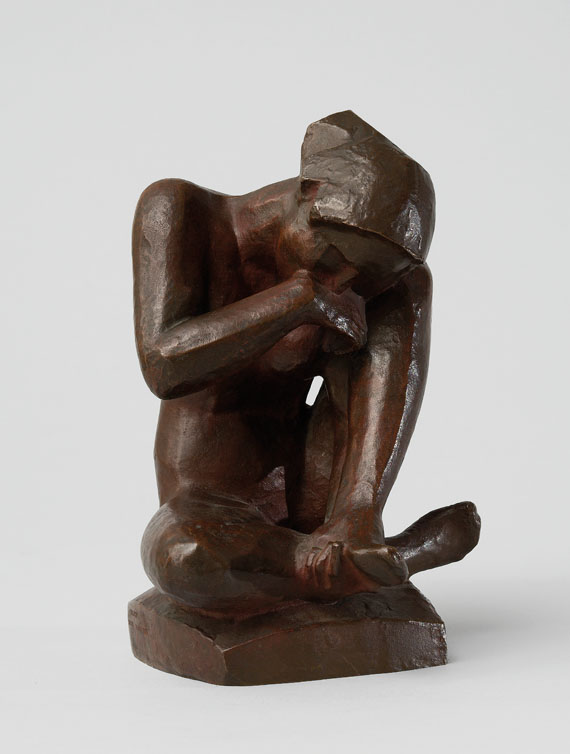
(incl. surcharge)
Kleine Hockende. 1923.
In the 1920s Georg Kolbe developed an avid interest in Expressionist painting. He acquired works by Kirchner and Pechstein and Schmidt-Rottluff was a lifelong friend. Kolbe was equally fascinated with the rediscovered art of medieval Europe as well as recently discovered non-European art forms. Kolbe’s preoccupation with these aesthetic influences confirmed him in the direction he had already taken. Abandoning a naturalistic approach to his models, he began to create figures that, in their stylised outlines and crisp angularity, have exchanged the delicate forms of his earlier works for vigorous vitality.
In 1936 the 'Reichskulturkammer' accepted the 'Deutscher Künstlerbund', of which Kolbe was the chairman, as a member. Towards the end of the war the artist's house and studio were damaged so that he moved to Hiershagen in Silesia until the beginning of 1945. After his return to Berlin he became severely ill and died in 1947. Apart from his numerous portraits Kolbe , who was one of the first autonomous sculptors and thus no longer determined by his sponsors, concentrated on nude sculptures which influenced the following generation of sculptors. [NB]
PROVENIENZ: Private collection South Germany.
An edition or the exact number of copies of the "Kleinen Hockenden" is unknown. The sculpture, also called "Trauernde" or "Kleine Sitzende" seems to be very rare. One copy is in possession of the Von-der-Heydt-Museum Wuppertal, acquired in 1942 (inv.no.: P 0132)
Bronze with dark brown to red patina.
Not recorded in Berger. With the monogram and the foudry mark "H. Noack Berlin Friedenau". cm ( in)Height: 18,8 cm (7,4 in) Georg Kolbe first studied painting in Dresden and Munich. The sculpture of Rodin, which he studied closely during a sojourn of half a year in Paris in 1897 awakened Kolbe's interest in sculpture. When Kolbe moved to Rome in 1898, Louis Tuaillon, the most important Neo-Classicist sculptor played an important role. Kolbe's first portrait sculptures were made under Tuaillon's guidance. After six years during which he also travelled in Italy, France, Belgium and Holland, Kolbe decided move to Berlin. In 1913 the sculptor left the 'Berliner Sezession' which he had joined in 1905 to join the 'Freie Sezession'. At the outbreak of the war in 1914 he was sent to East Prussia and Poland as a volunteer, in 1918 he was sent to the Black Forest. In the same year the Prussian Ministry of Cultural Affairs appointed him professor.
In good condition. Minimally shop-soiled in places. Base with two tiny white traces of rubbing.
(incl. surcharge)




 Lot 297.10
Lot 297.10 